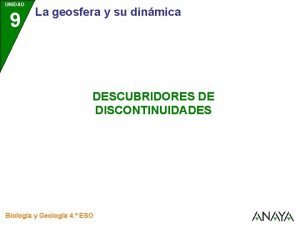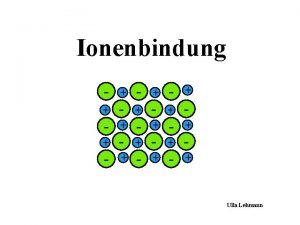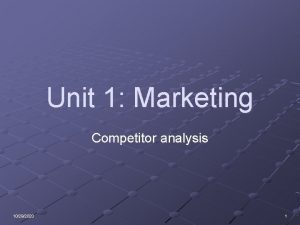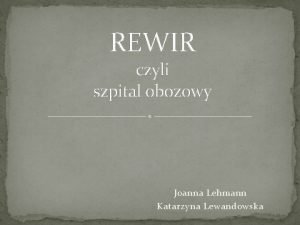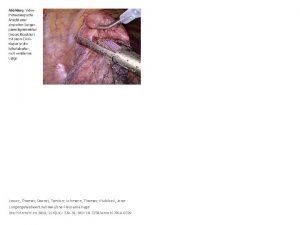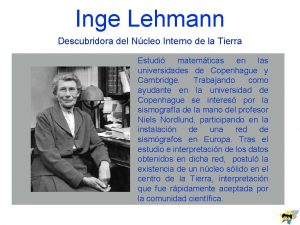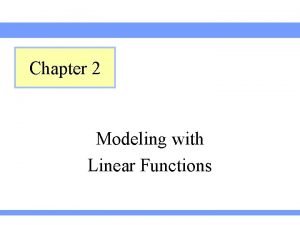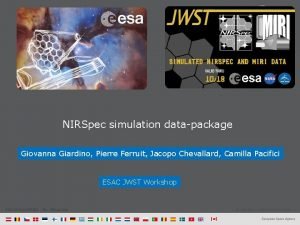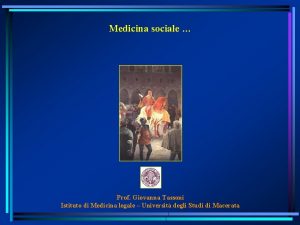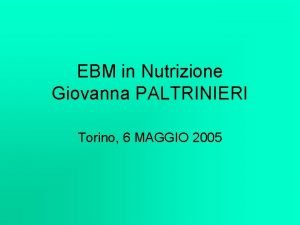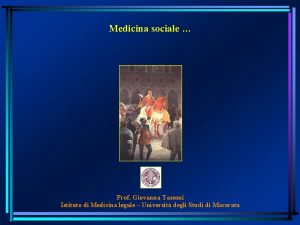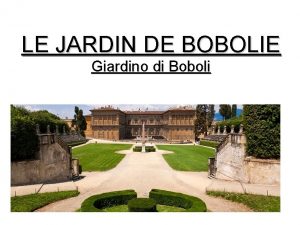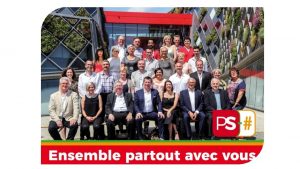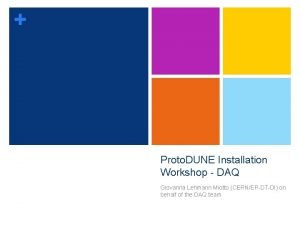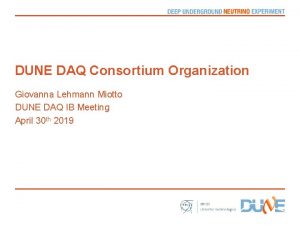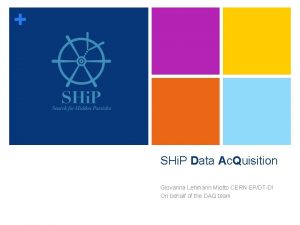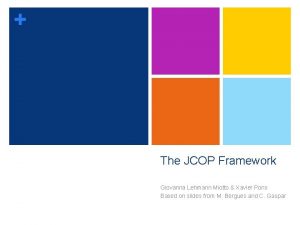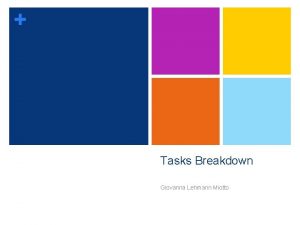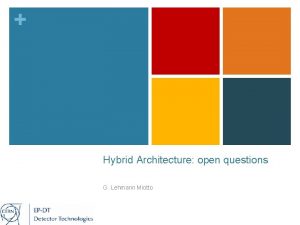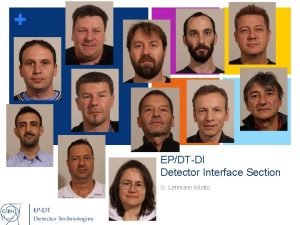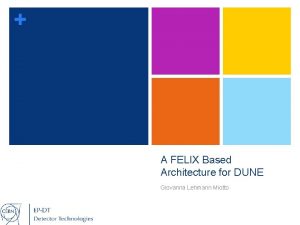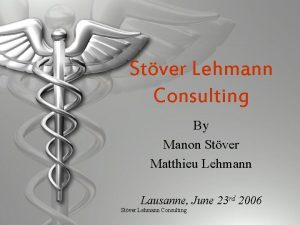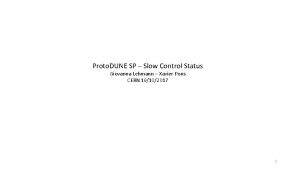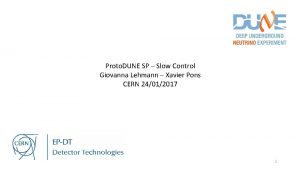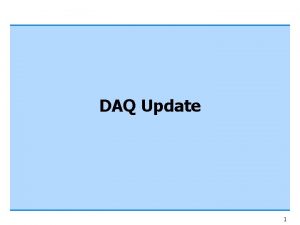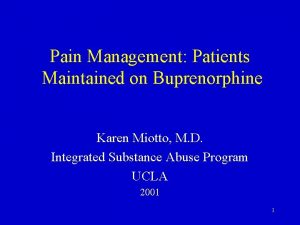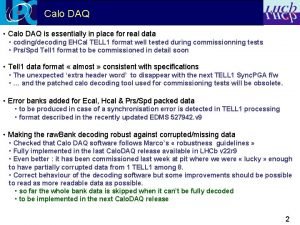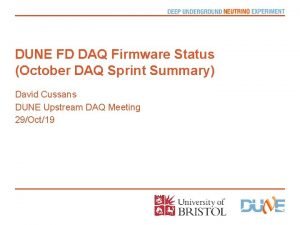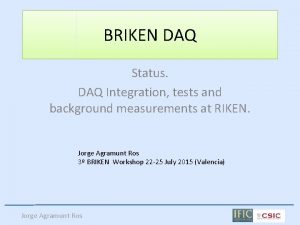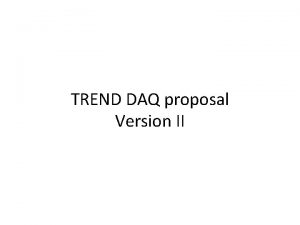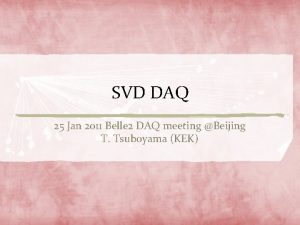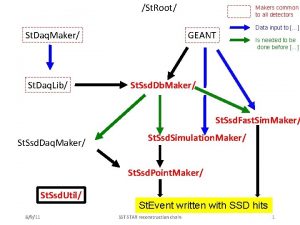DAQ Architecture Giovanna Lehmann Miotto DAQ Design Review


























- Slides: 26

DAQ Architecture Giovanna Lehmann Miotto DAQ Design Review 3 Nov 2016

Introduction • From DUNE DAQ to Proto. DUNE DAQ • External interfaces and constraints • DAQ logical architecture • Main DAQ components and their interaction • Risks & timescales • Summary 2 3. 11. 2016 G. Lehmann Miotto | DAQ Architecture

DUNE Trigger and DAQ Requirements • Very high up-time (>99%) • Collect beam+atmospheric neutrinos as well as proton decay candidates (Etot>100 Me. V) with high resolution and no deadtime • Collect interactions with Etot<100 Me. V with a limited zerosuppression loss • Be able to trigger on beam pulses irrespective of the deposited energy • Collect data with the most favorable zero-suppression possible over >10 s periods (supernova trigger) • + all DAQ ancillaries (event building, calibration, control, …) Difficult to satisfy so varied requirements! 3 3. 11. 2016 G. Lehmann Miotto | DAQ Architecture

Main Trigger & DAQ Features • The DUNE DAQ is designed combining ideas of - Continuous readout systems - Triggered systems • No dead time achieved by streaming the data summaries into a trigger farm and keeping raw data in ring buffers on readout system during decision making - HE events: • trigger request sent to readout system and data fully readout, built, processed, stored - LE events: 4 • Trigger stream of hits are useful for SNB analysis and will be buffered/stored as long as possible (ring buffer of disk files) • When a SNB is noticed in the trigger farm, it directs to also extract data from ring buffers 3. 11. 2016 G. Lehmann Miotto | DAQ Architecture

Detectors’ Electronics Sketch of the DUNE DAQ 5 3. 11. 2016 Off detector readout systems Data summaries Trigger Farm Ring Buffer Data Processing Farm G. Lehmann Miotto | DAQ Architecture

Detectors’ Electronics Sketch of the DUNE DAQ 6 3. 11. 2016 Off detector readout systems Data summaries Trigger Farm Ring Buffer Data Processing Farm G. Lehmann Miotto | DAQ Architecture

Detectors’ Electronics Sketch of the DUNE DAQ 7 3. 11. 2016 Off detector readout systems Data summaries Trigger Farm Ring Buffer Data Processing Farm G. Lehmann Miotto | DAQ Architecture

Detectors’ Electronics Sketch of the DUNE DAQ Off detector readout systems Data summaries Ring Buffer Data Processing Farm Zero suppression and compression occurring at different stages of the DAQ, depending on trigger type. 8 3. 11. 2016 Trigger Farm G. Lehmann Miotto | DAQ Architecture

From DUNE to Proto. DUNE SP • Smaller - 0. 77 kt vs 10 kt LAr per DUNE module; only 1 module - Less components but each component is full-scale pre-production module; only 6 APA • On surface - Higher flux of cosmic ray particles • On SPS beam line - charged particles 0. 5 – 7 Gev/c • The rate and volume of data produced by these detectors will be substantial (O(Tb/s)) 9 3. 11. 2016 G. Lehmann Miotto | DAQ Architecture

The Proto. DUNE DAQ Environment • 6 Anode Plane Assemblies (APA) - TPC ~ 430 Gb/s (15 k. Ch @ 2 MHz) - Photon Detectors ~ 1 Gb/s (288 Si. PM, headers only) • Beam instrumentation (BI) & Cosmic Rays Tagger (CRT) detectors - Negligible throughput • SPS super cycle structure: 2 x 4. 8 s bursts in 48 s - Full readout -> ~85 Gb/s - Too much for DAQ as well as for storage! • Introduction of a simple trigger to mitigate data flow - Retain full readout off detector • Use of lossless data reduction techniques 10 3. 11. 2016 G. Lehmann Miotto | DAQ Architecture

From DUNE to Proto. DUNE DAQ Off detector readout systems ✗ Photon Detectors TPC Data summaries Ring Buffer Data summaries Data Processing Farm Beam Instrumentation, cosmic μtagger 3. 11. 2016 ✗ Trigger Farm Off detector readout system Trigger 11 ✗ G. Lehmann Miotto | DAQ Architecture

The 35 t prototype DAQ • HERE SLIDE FROM GILES 12 3. 11. 2016 G. Lehmann Miotto | DAQ Architecture

Scope of the Proto. DUNE DAQ • Provide service to the detector/electronics validation - Take and store data safely and efficiently - Reuse existing components, experience, … • Evaluate DAQ solutions and technologies that may be suitable for DUNE - TPC readout system - Data storage - Dataflow software (hardware fully COTs servers + switches) - Control and monitoring software 13 3. 11. 2016 G. Lehmann Miotto | DAQ Architecture

Interfaces TPC (Wi. B) SPS Spill Signal Timing + Trg out Photon Detectors (SSP) Data Beam Instrumentation DAQ Trg In Data files + metadata CRT 14 3. 11. 2016 G. Lehmann Miotto | DAQ Architecture Offline Computing

Constraints • Decoupling - The DAQ needs to ensure a proper decoupling between the “online” and the “offline” worlds • Sufficient storage space for raw data files on the DAQ side should be available to store up to 3 days worth of data taking. • Grounding - Try to keep all DAQ equipment on building ground - Any link connecting the detector must be isolated -> optical • Direct impact on readout, timing, trigger 15 3. 11. 2016 G. Lehmann Miotto | DAQ Architecture

Grounding Isolation Detector Ethernet switch SSP Building Other DAQ equipment Trigger Board Timing WIB 16 3. 11. 2016 G. Lehmann Miotto | DAQ Architecture Beam Instrumentation CRT

The Proto. DUNE DAQ Off detector readout systems Photon Detectors TPC Ring Buffer Event size ~ 60 MB (5 ms window, x 4 compression) Data Compression 24 Gb/s 430 Gb/s Event Building Farm Off detector readout system Summary Info Temporary Storage 25 Hz in burst Trg+Timing 20 Gb/s Beam Instrumentation, cosmic ray tagger 17 3. 11. 2016 G. Lehmann Miotto | DAQ Architecture DB EOS

Proto. DUNE Software • Dataflow software is based on art. DAQ developed at FNAL - Customizable “Board Reader” application - Event building - Dispatching to monitoring apps - Aggregation - Storage • Control, operational monitoring, graphical UIs - Joint COntrols Project (JCOP) toolkit developed originally for LHC experiments - Uniform interface also for detector control and safety systems • Software approach - Minimize the risks by relying on existing frameworks - Focus effort only on experiment specific needs 18 3. 11. 2016 G. Lehmann Miotto | DAQ Architecture

Readout of External Systems • PDS - On detector electronics already does data reduction and sends data over TCP/IP (-> DAQ starts at Board Reader) • TPC (point-to-point optical links from Wi. B) - 2 solutions being implemented • Baseline: ATCA platform from SLAC • Prototype alternative: ATLAS FELIX + network connected PCs - 5 APAs will be readout via ATCA boards (12800 ch), 1 APA (2560 ch) via FELIXs • 2 firmware variants in electronics (Wi. B) • API for transparently treating data at software level • Provision to read out all system with ATCA • From a software point of view the interface towards the event builder is the Board Reader application for all readout systems 19 3. 11. 2016 G. Lehmann Miotto | DAQ Architecture

Proto. DUNE Data Flow Trg/Timing Board Reader 1 3 Data. Flow Orchestrator Board Reader 4 10 Gbps Ethernet (Brocade ICX 7750) 2 5 20 3. 11. 2016 Event Builder G. Lehmann Miotto | DAQ Architecture Event Builder Aggregator/ Storage

DAQ Temporary Storage • I/O requirements similar to ATLAS/CMS now • Hardware solution similar to ATLAS data loggers (modular!) • Transfer to EOS using F-FTS and XRoot. D Courtesy W. Vandelli, CERN 21 3. 11. 2016 G. Lehmann Miotto | DAQ Architecture

Proto. DUNE Trigger Throttling Trg/Timing Readout full/free -> BUSY/NBUSY Board Reader Due to the low trigger rates and the “continuous” readout mode DFO full/free of on-detector electronics, software throttling seems sufficient -> BUSY/NBUSY -> hardware throttling still possible as an option Data. Flow Orchestrator EB cannot get rid of events -> DFO cannot assign new events Event Builder 22 3. 11. 2016 G. Lehmann Miotto | DAQ Architecture No storage space or slowed down disk writing -> EB cannot clear events Event Builder Aggregator/ Storage

A Word on Partitioning • Partitioning = the mechanism by which multiple copies of the DAQ can run on a same installation • The DAQ has a few elements that cannot be split - (Virtual) duplication to allow for parallel running • Partitioning is normally extremely useful during commissioning & testing - Even if it wasn’t a requirement from the experiment point of view it is a requirement from the DAQ side • Proposal to be able to partition the system into vertical slices, i. e. by APA - Only one partition will make use of the central trigger board, while others will use random or constant rate triggers 23 3. 11. 2016 G. Lehmann Miotto | DAQ Architecture

Proto. DUNE Timeline Nov‘ 16 Jun’ 17 Test 1 st APA TDR DAQ design review DAQ ~functional 24 3. 11. 2016 End’ 18 LS 2 Jul‘ 18 Data Taking Installation complete DAQ complete G. Lehmann Miotto | DAQ Architecture Continue data taking and R&D in 2019, possibly….

Risks • External Interfaces - Detailed specs (physical links, connectors, protocols, information content) - Continuous interaction between sub-system leaders AND detailed work sessions with sub-system specialists • Internal Interfaces - New timing system to be integrated with trigger and many endpoints - Detailed specs and regular meetings - Continuous integration testing! • Resources - We are confident that the people and institutions that committed to the DAQ will deliver on their components - Sufficient effort will be needed @CERN to ensure smooth integration, commissioning, tuning, operation 25 3. 11. 2016 G. Lehmann Miotto | DAQ Architecture

Summary • A complete design of the DAQ system exists - Interfaces - Components model, Interactions and data flow • All hardware components required for the DAQ identified - COTs servers, switches, interconnects (not a large system!), storage solution - ATCA based SLAC solution - FELIX PCIe cards - Timing units - Central Trigger board • Main risks have been identified at the external interfaces level - Mitigation through direct discussions at different levels • We are confident that the proposed DAQ design can be implemented on the timescales required by Proto. DUNE, that it satisfies the requirements that have been put forward by the experiment and that it has sufficient modularity to allow for flexibility, in case of additional performance needs. 26 3. 11. 2016 G. Lehmann Miotto | DAQ Architecture
 Saskia lehmann
Saskia lehmann Moho gutenberg lehmann
Moho gutenberg lehmann Aufbau des natriumchloridkristalls
Aufbau des natriumchloridkristalls Psychoakustik
Psychoakustik Lehmann and winer competitor analysis
Lehmann and winer competitor analysis Joanna lehmann
Joanna lehmann Inge lehmann
Inge lehmann Christina lehmann
Christina lehmann Torsten lehmann
Torsten lehmann Inge lehman
Inge lehman Lehmann linear
Lehmann linear édith giovanna gassion
édith giovanna gassion Theo sarapo se suicidó
Theo sarapo se suicidó Genre of federigo's falcon
Genre of federigo's falcon Edith gassion
Edith gassion Giovanna savorani
Giovanna savorani Giovanna giardino esa
Giovanna giardino esa Giovanna tassoni
Giovanna tassoni Giovanna koning
Giovanna koning Giovanna ghiani nutrizionista
Giovanna ghiani nutrizionista Giovanna paltrinieri
Giovanna paltrinieri Giovanna marotta
Giovanna marotta Irony in federigo's falcon
Irony in federigo's falcon Medicina sociale definizione
Medicina sociale definizione Bobolie
Bobolie Edith piaf vrai nom
Edith piaf vrai nom Giovanna verolla
Giovanna verolla

